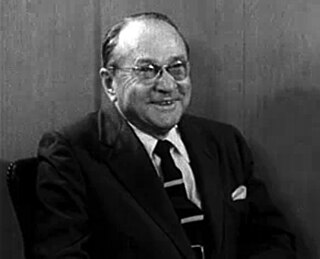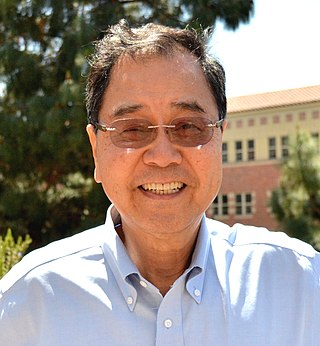Related Research Articles

Nanotechnology is the manipulation of matter with at least one dimension sized from 1 to 100 nanometers (nm). At this scale, commonly known as the nanoscale, surface area and quantum mechanical effects become important in describing properties of matter. This definition of nanotechnology includes all types of research and technologies that deal with these special properties. It is common to see the plural form "nanotechnologies" as well as "nanoscale technologies" to refer to research and applications whose common trait is scale. An earlier understanding of nanotechnology referred to the particular technological goal of precisely manipulating atoms and molecules for fabricating macroscale products, now referred to as molecular nanotechnology.

Vladimir Kosma Zworykin was a Russian-American inventor, engineer, and pioneer of television technology. Zworykin invented a television transmitting and receiving system employing cathode ray tubes. He played a role in the practical development of television from the early thirties, including charge storage-type tubes, infrared image tubes and the electron microscope.

Epitaxy refers to a type of crystal growth or material deposition in which new crystalline layers are formed with one or more well-defined orientations with respect to the crystalline seed layer. The deposited crystalline film is called an epitaxial film or epitaxial layer. The relative orientation(s) of the epitaxial layer to the seed layer is defined in terms of the orientation of the crystal lattice of each material. For most epitaxial growths, the new layer is usually crystalline and each crystallographic domain of the overlayer must have a well-defined orientation relative to the substrate crystal structure. Epitaxy can involve single-crystal structures, although grain-to-grain epitaxy has been observed in granular films. For most technological applications, single-domain epitaxy, which is the growth of an overlayer crystal with one well-defined orientation with respect to the substrate crystal, is preferred. Epitaxy can also play an important role while growing superlattice structures.

Molecular-beam epitaxy (MBE) is an epitaxy method for thin-film deposition of single crystals. MBE is widely used in the manufacture of semiconductor devices, including transistors, and it is considered one of the fundamental tools for the development of nanotechnologies. MBE is used to fabricate diodes and MOSFETs at microwave frequencies, and to manufacture the lasers used to read optical discs.
Alfred Yi Cho is a Chinese-American electrical engineer, inventor, and optical engineer. He is the Adjunct Vice President of Semiconductor Research at Alcatel-Lucent's Bell Labs. He is known as the "father of molecular beam epitaxy"; a technique he developed at that facility in the late 1960s. He is also the co-inventor, with Federico Capasso of quantum cascade lasers at Bell Labs in 1994.
William Ralph Bennett Jr. was an American physicist known for his pioneering work on gas lasers. He spent most of his career on the faculty of Yale University.

James S. Harris is a scientist and engineer and fellow of IEEE, American Physical Society and Optical Society of America. His research primarily deals with optoelectronic devices and semiconductor material research.
Ben G. Streetman is the former dean of the Cockrell School of Engineering at the University of Texas at Austin. He earned a Ph.D. in electrical engineering from Texas in 1966, and became a professor there in 1982. He founded the university's Microelectronics Research Center and holds the Dula D. Cockrell Centennial Chair Emeritus in Engineering. Streetman is a member of the American Academy of Arts and Sciences and the National Academy of Engineering. He is a fellow of the Institute of Electrical and Electronics Engineers (IEEE) and the Electrochemical Society. He was awarded the IEEE Education Medal in 1989.
The initially called Morris Liebmann Memorial Prize provided by the Institute of Radio Engineers (IRE), the IEEE Morris N. Liebmann Memorial Award was created in 1919 in honor of Colonel Morris N. Liebmann. It was initially given to awardees who had "made public during the recent past an important contribution to radio communications". The award continued to be awarded as the IEEE Morris N. Liebmann Memorial Award by the board of directors of the Institute of Electrical and Electronics Engineers (IEEE) after the IRE organization merged into the IEEE in 1963. The scope was changed to "for important contributions to emerging technologies recognized within recent years". After 2000, the award was superseded by the IEEE Daniel E. Noble Award.
Ian Munro Ross FREng was an early pioneer in transistors, and for 12 years President of Bell Labs.
The James C. McGroddy Prize for New Materials is a prize that has been awarded annually by the American Physical Society since 1975, but was only given that name following its endowment by IBM in 1999. Prior to that it was known as the International Prize for New Materials. The recipients are chosen for "Outstanding achievement in the science and application of new materials". The prize is named after James C. McGroddy, himself a winner of APS's George E. Pake Prize in 1995, and comes with a cash award of $10,000.
A molecular beam is produced by allowing a gas at higher pressure to expand through a small orifice into a chamber at lower pressure to form a beam of particles moving at approximately equal velocities, with very few collisions between the particles. Molecular beams are useful for fabricating thin films in molecular beam epitaxy and artificial structures such as quantum wells, quantum wires, and quantum dots. Molecular beams have also been applied as crossed molecular beams. The molecules in the molecular beam can be manipulated by electrical fields and magnetic fields. Molecules can be decelerated in a Stark decelerator or in a Zeeman slower.
M. George Craford is an American electrical engineer known for his work in Light Emitting Diodes (LEDs).
Richard J. Gambino was an American material scientist best known for his pioneering work with amorphous magnetic materials.
David Albert Hodges (1937–2022) was an American electrical engineer, digital telephony pioneer, and professor of electrical engineering at the University of California, Berkeley.

Kang Lung Wang is recognized as the discoverer of chiral Majorana fermions by IUPAP. Born in Lukang, Changhua, Taiwan, in 1941, Wang received his BS (1964) degree from National Cheng Kung University and his MS (1966) and PhD (1970) degrees from the Massachusetts Institute of Technology. In 1970 to 1972 he was the Assistant Professor at MIT. From 1972 to 1979, he worked at the General Electric Corporate Research and Development Center as a physicist/engineer. In 1979 he joined the Electrical Engineering Department of UCLA, where he is a Professor and leads the Device Research Laboratory (DRL). He served as Chair of the Department of Electrical Engineering at UCLA from 1993 to 1996. His research activities include semiconductor nano devices, and nanotechnology; self-assembly growth of quantum structures and cooperative assembly of quantum dot arrays Si-based Molecular Beam Epitaxy, quantum structures and devices; Nano-epitaxy of hetero-structures; Spintronics materials and devices; Electron spin and coherence properties of SiGe and InAs quantum structures for implementation of spin-based quantum information; microwave devices. He was the inventor of strained layer MOSFET, quantum SRAM cell, and band-aligned superlattices. He holds 45 patents and published over 700 papers. He is a passionate teacher and has mentored hundreds of students, including MS and PhD candidates. Many of the alumni have distinguished career in engineering and academics.
Leroy L. Chang was an experimental physicist and solid state electronics researcher and engineer. Born in China, he studied in Taiwan and then the United States, obtaining his doctorate from Stanford University in 1963. As a research physicist he studied semiconductors for nearly 30 years at IBM's Thomas J. Watson Research Center, New York. This period included pioneering work on superlattice heterostructures with Nobel Prize-winning physicist Leo Esaki.
Roger John Malik is a physicist, engineer and inventor.

Aristos Christou is an American engineer and scientist, academic professor and researcher. He is a Professor of Materials Science, Professor of Mechanical Engineering and Professor of Reliability Engineering at the University of Maryland.
Gallium indium antimonide, also known as indium gallium antimonide, GaInSb, or InGaSb (GaxIn1-xSb), is a ternary III-V semiconductor compound. It can be considered as an alloy between gallium antimonide and indium antimonide. The alloy can contain any ratio between gallium and indium. GaInSb refers generally to any composition of the alloy.
References
- IEEE Morris N. Liebmann Memorial Award recipients
- "Atom by Atom, Physicists Create Matter that Nature has Never Known Before", New York Times, June 1, 1982.
- W. Patrick McCray, "MBE deserves a place in the history books", Nature Nanotechnology 2, 259 - 261 (2007) .